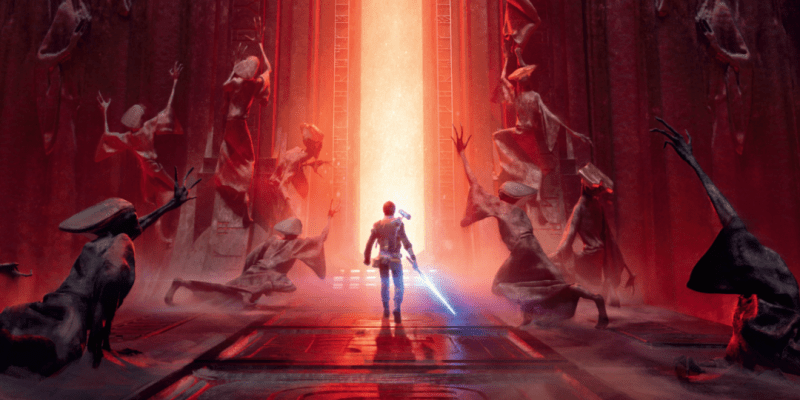This piece contains story spoilers for Star Wars Jedi: Fallen Order.
Star Wars Jedi: Fallen Order‘s Cal Kestis isn’t a human being. I mean, obviously he’s played by one and canonically human, but there’s absolutely no life behind those eyes. We see Cal’s best friend die before his very eyes, yet save for a single outburst immediately afterwards, we never hear about this friend or that sense of loss ever again. This man spent years working alongside Cal, was willing to lay down his life for him, and yet I don’t know anyone who can recite his name. (It’s Prauf, by the way. Yes, I had to look it up.) And why would they? It’s not like Cal ever mentions him afterward. In fact, I’m not sure Cal cares about anyone who isn’t Force-sensitive.
Cal is ostensibly a good guy, yet he shows no regrets over anyone but his Jedi Master dying. Cal kills easily over a hundred sentient beings over the course of Jedi: Fallen Order yet never wavers. He singlehandedly slaughters an entire tribe of Dathomirian Nightbrothers and doesn’t even begin to regret it. Who cares if the tribe tries three times in a row to make him walk away without a major confrontation, or that their culture is already nearly extinct?
There’s very little to Cal Kestis. We never see him in his downtime or understand who he is outside of his actions as a Jedi. So, what we discern is that these acts of cold stoicism and violence are seemingly common for him. The only people he’ll stop and bother speaking to are all Force-sensitive or immediately useful to his mission. Other beings are tools to an end, not living people with their own existences just as important as Cal’s. This is the man we’re supposed to view as a hero, as our Jedi fantasy. Instead, he’s a man without humanity.
Many action game protagonists are accused of narrative dissonance for being manslaughter machines with a heart of gold. However, the circumstances that often force the hands of your typical action hero are driven by the environment; they’re responding to a threat, rather than instigating it. That’s not the case here.

Cal didn’t need to draw his lightsaber when Prauf was obviously giving himself up to the Inquisition; it actually invalidates Prauf’s sacrifice. Cal didn’t need to pursue the Jedi holocron he spends an entire game searching for; in the end, he shatters it anyway. Not that that matters, as readers of the Darth Vader comic by Charles Soule will know that Darth Vader has already smashed the original holocron that Star Wars Jedi: Fallen Order’s holocron is copied off of. So whether Cal had lived or died, the end result would be the same, except a lot more people would be alive if Cal had died or minded his own business.
In fact, nothing about Cal’s actions truly benefits the galaxy. Saw Gerrera’s troops were liberating Kashyyyk with or without him, and in the end both Cal and Saw abandon Kashyyyk before the job’s done. Nightsister Mirren was rebuilding her society; now Dathomir is in ruins again while she rides along with Cal to see the galaxy. Zeffo’s still occupied Imperial territory. Bogano has a few less wild beasts. Ilum is still being strip mined for kyber crystals. Nothing was accomplished except a whole mess of people dying, many of them not even having a say in the matter.
This is what I mean when I said in my review that the Second Sister is vastly more sympathetic despite being a murderous Sith Inquisitor. We learn that the Second Sister was abandoned and misled by her Jedi Master, betrayed while she tried to protect younglings from the Empire by the woman who practically raised her, tortured beyond belief, and she’s still not let that tear her down. She has goals: to survive and to transcend the weakness of her Jedi Master.
The Second Sister is efficient and gets the job done. She makes banter and plays with her opponent’s expectations. Her presence always shifts circumstances too. She finds the temple on Zeffo before Cal. She neutralizes the rebellion on Kashyyyk and restores Imperial order in seemingly a day. The Second Sister accomplishes so much in a handful of actions. She has a history and motivation that we can relate to. We all know what it’s like to feel betrayed and to endure hardship only to improve ourselves.
With the Second Sister, we even understand why she and her master clash now, because we know her master. Cere may claim she’s no longer a Jedi, but she is clearly meant to be Cal’s mentor, and as such, we learn enough about her to understand her as a person. She’s a coward who has to overcome her fears and guilt, but we can see how these two characters pushed each other down their respective paths.

Compare Cere to Cal’s first master, Tapal, who dies during Order 66. What do we know about him? He’s of the Lasat and as stoic as can be. There’s no reason for us to care about him dying, so when he does and Cal reacts, we can’t relate. This isn’t the loss of some father figure or something; it’s a man we’ve known for maybe five minutes who leaves next to no impression. He actually has less dialogue with Cal than Prauf, yet he is the person Cal references whenever he expresses regret over anyone’s passing. He breaks his own lightsaber over his guilt at not saving Tapal during Order 66. That we can’t even begin to relate to that feeling of loss is a failure of storytelling.
And that lightsaber breaking is when Star Wars Jedi: Fallen Order forgoes its own lessons. A Jedi is more than a lightsaber. Their lightsaber is just a tool. Yet Fallen Order treats the loss of Cal’s saber as him having entirely lost his way as a Jedi. Why is that? He still has the Force, yet everything in Fallen Order is somehow built around your lightsaber to such an extent that Cal is nothing without his saber. He’s no Jedi. He’s a boy with a sword playing at being a Jedi.
This highlights one of Fallen Order’s greatest failings in its design. Respawn said they wanted a Souls-like experience, yet Fallen Order forgets that one of the most crucial parts of Dark Souls is the myriad ways you can solve most of its encounters. Players are granted the freedom to adapt as they see fit, across dozens of potential play styles. You have only one play style in Fallen Order, because even mechanically, Cal has no expression of depth.
Everyone obtains the same upgrades, earns the same moves, and faces the same opponents in the same manner. It’s not that this progression and game design is inherently bad, but it inherently limits Fallen Order’s gameplay. For all the ancient temples Cal visits and the other Force sensitives he speaks to, the best he can do is murder Stormtroopers. He’s not a keeper of the peace; he’s a soldier and a betrayer of what the Jedi should be. His concern is solely bringing down the Empire and restoring the Order as it once was.
Nothing Cal Kestis does contributes to anything constructive. All he does is leave destruction in his wake. I’m glad that Star Wars Jedi: Fallen Order is a prequel set before A New Hope and that Cal Kestis is doomed to failure. He might’ve survived this game, but his luck will run out. Because if Cal Kestis were the one to build the new Jedi Order, they’d be no better than the Inquisition that came before it.
